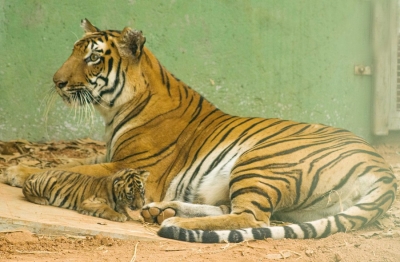Maha's tiger count triples since 2010 despite poaching, shrinking corridors
By IANS | Published: April 8, 2023 11:57 AM2023-04-08T11:57:02+5:302023-04-08T12:05:08+5:30
By Quaid Najmi Mumbai, April 8 Fifty years after Maharashtra's first tiger reserve came up in Melghat (Amravati) ...

Maha's tiger count triples since 2010 despite poaching, shrinking corridors
By Quaid Najmi
Mumbai, April 8 Fifty years after Maharashtra's first tiger reserve came up in Melghat (Amravati) out of the nine set up across India, the big cat is flourishing well in the state, with its population shooting above 350 now.
From that single sanctuary established on April 1, 1973, the state today has six tiger reserves and the big cat is now the 'uncrowned king' of Chandrapur, known as the 'tiger district', with around 200 roaming there freely.
Experts working in the field of tiger conservation say that the Project Tiger initiative launched by then Prime Minister Indira Gandhi 50 years ago has been a "success story" that helped pull back the big cat from the brink of extinction.
Not only is 'Tiger Zinda Hai' in Maharashtra, but thriving exceedingly well with the population increasing constantly, growing by nearly five times in the state and in varying degrees in the 49 other tiger reserves across India.
"Compared to over 40,000 tigers barely 150 years ago, in 1971, the country was left with around 1,750 big cats. Of these, Maharashtra had around 75 tigers. Today, the tiger population is growing at an average of 10-12 per cent to touch around 325," said Yadav Tarte-Patil, former member of State Board for Wild Life (SBWL), Maharashtra.
Citing the slow but steady growth, Tarte-Patil said that in 2006, the state had 103 tigers, in 2010 it increased to 169, followed by 190 in 2015 and 312 in 2018, and the current estimate (2022) is over 350.
Another expert and Bombay Natural History Society's (BNHS) Secretary, Kishore Rithe, said that despite huge challenges faced over the past five decades, Project Tiger has been a resounding success, though many threats still remain.
Earlier, there was the problem of relocating the villagers living in and around the tiger reserves, especially in Amravati-Chandrapur, which was done successfully over the decades.
"Now, with a lucrative compensation-cum-rehabilitation policy (considered the best after Madhya Pradesh), people are willingly coming forward to relocate to safer areas outside the tiger zones," said Rithe.
But the human species growth is also rapid 57 per cent in comparison to the increase in tiger population (10-12 per cent), so despite having more tiger territories, the pressures from humans has increased heavily, leading to avoidable man-animal conflicts, the experts pointed out.
"The tiger corridors linking the reserves through jungle routes are still facing great threats. There are many infrastructure projects like highways, roads, railway lines, canals, power lines, factories or mines that keep coming up and affect the tigers," said Rithe.
Tarte-Patil said that poaching also remains a concern, though now under control, with the elite Special Tiger Protection Force (STPF) comprising around 300 troopers specially trained and assigned to protect the big cats from the illegal gun-totters always lurking around.
"In the past 10 years alone, the state has lost 185-plus tigers due to poaching, which continues at the rate of 43 per cent. One of the reasons is owing to vacancies of forest guards and other staff, hence, many times, the STPF is diverted to other duties," said Tarte-Patil.
The tiger reserves in the state are: Melghat, Tadoba, Pench, Bor, Nagzira all in eastern Maharashtra, and the lone Sahyadri in western Maharashtra that offer survival and solace to the big cats of the 'Royal Bengal Tiger' species, one of the nine global species of which three have become extinct.
Rithe said that slowly, for various reasons, tigers are now dispersing from their concentrated spread in the 11 districts of Vidarbha and four in the Sahyadri reserve.
"Now, tigers are sighted till the Gujarat border, in Jalgaon, Nandurbar, Dhule and Pune, though it is unlikely that the big cat may ever again make Mumbai its home. Plus, tigers adapt to the local environment very slowly unlike leopards, which can adjust to any habitat quickly and make it their home," Rithe added.
The last known record of a tiger shot dead in Mumbai (then Bombay) dates back to February 1929, 94 years ago, and since then, the suburban Mumbaikars are grappling with its spotted cousin, the leopard.
Disclaimer: This post has been auto-published from an agency feed without any modifications to the text and has not been reviewed by an editor
Open in app